Study on Temporal and Spatial Characteristics of Fuzhou Built-Up Area Based on Remote Sensing Data of Nighttime Light
Abstract
:1. Introduction
2. Study Area and Dataset
2.1. Study Area
2.2. Dataset
2.3. Data Preprocessing
2.3.1. Landsat Image
2.3.2. DMSP/OLS
2.3.3. NPP-VIIRS
2.3.4. Calibration between DMSP/OLS and NPP-VIIRS Data Sets
3. Research Methods
3.1. Extraction of Urban Built-Up Area Based on NTL Data
3.2. Urban Built-Up Area Extraction Based on Landsat Image
3.3. Spatio-Temporal Dynamic Evolution Analysis
3.3.1. Nighttime Light Index Analysis
3.3.2. Analysis of Expansion Speed and Strength
3.3.3. Analysis of Expansion Direction
3.4. Analysis of Spatial Form Evolution
3.4.1. Fractal Dimension Analysis
3.4.2. Compactness Analysis
3.4.3. Analysis of Center of Gravity Shift
4. Experiment and Conclusion
4.1. Extraction Results of Built-Up Area
4.2. Results of Spatio-Temporal Dynamic Development
4.3. Results of Spatial Morphology Evolution
5. Discussion
5.1. Driving Forces
5.1.1. Population Factors
5.1.2. Economic Factors
5.2. Impact Factors
5.2.1. Natural Conditions
5.2.2. Policy Guidance
6. Conclusions
Author Contributions
Funding
Institutional Review Board Statement
Informed Consent Statement
Data Availability Statement
Acknowledgments
Conflicts of Interest
References
- Zhang, T.; Liang, J.; Song, J. Summarization of studies on measuring of urbanization in China. Urban Dev. Stud. 2022, 2, 36–41. [Google Scholar]
- Fang, C. The urbanization and urban development in China after the reform and opening-up. Econ. Geogr. 2009, 29, 19–25. [Google Scholar]
- Zhang, X.; Li, P. A temperature and vegetation adjusted NTL urban index for urban area mapping and analysis. ISPRS J. Photogramm. 2018, 135, 93–111. [Google Scholar] [CrossRef]
- Levin, N.; Kyba, C.C.M.; Zhang, Q.; Alejandro, S.M.; Roman, M.O.; Li, X.; Portnov, B.A.; Molthan, A.L.; Jechow, A.; Miller, S.D.; et al. Remote sensing of night lights: A review and an outlook for the future. Remote Sens. Environ. 2020, 237, 111443. [Google Scholar] [CrossRef]
- Xu, J.; Song, J.; Li, B.; Liu, D.; Cao, X. Combining night time lights in prediction of poverty incidence at the county level. Appl. Geogr. 2021, 135, 102552. [Google Scholar] [CrossRef]
- Croft, T.A. Nighttime Images of the Earth from Space. Sci. Am. 1978, 239, 86–101. [Google Scholar] [CrossRef]
- Ma, L.; Wu, J.; Li, W.; Peng, J.; Liu, H. Evaluating Saturation Correction Methods for DMSP/OLS Nighttime Light Data: A Case Study from China’s Cities. Remote Sens. 2014, 6, 9853–9872. [Google Scholar] [CrossRef] [Green Version]
- Li, X.; Zhou, Y. A Stepwise Calibration of Global DMSP/OLS Stable Nighttime Light Data (1992–2013). Remote Sens. 2017, 9, 637. [Google Scholar] [CrossRef] [Green Version]
- Mukherjee, S.; Srivastav, S.K.; Gupta, P.K.; Hamm, N.A.S.; Tolpekin, V.A. An Algorithm for Inter-calibration of Time-Series DMSP/OLS Night-Time Light Images. Proc. Natl. Acad. Sci. India Sect. A Phys. Sci. 2017, 87, 721–731. [Google Scholar] [CrossRef]
- Henderson, M.; Yeh, E.T.; Gong, P.; Elvidge, C.; Baugh, K. Validation of urban boundaries derived from global night-time satellite imagery. Int. J. Remote Sens. 2003, 24, 595–609. [Google Scholar] [CrossRef]
- Lan, W.; Fu, B.; He, H.; Liu, M.; Gao, E.; Fan, D. Spatiotemporal dynamics of urban patterns in Guangxi based on multi-temporal night-light and optical remote sensing data. J. Guilin Univ. Technol. 2022, 2, 1–18. [Google Scholar]
- Mi, X.; Bai, Y.; Tan, X.; Lu, N.; Peng, G.; Shao, Q. A new method for urban center extraction based on DMSP/OLS data. J. Geo-Inf. Sci. 2013, 15, 225–261. [Google Scholar]
- Pandey, B.; Joshi, P.K.; Seto, K.C. Monitoring urbanization dynamics in India using DMSP/OLS night time lights and SPOT-VGT data. Int. J. Appl. Earth. Obs. 2013, 23, 49–61. [Google Scholar] [CrossRef]
- Li, K.; Chen, Y. A Genetic Algorithm-based urban cluster automatic threshold method by combining VIIRS DNB, NDVI, and NDBI to monitor urbanization. Remote Sens. 2018, 10, 277. [Google Scholar] [CrossRef]
- Stokes, E.C.; Seto, K.C. Characterizing urban infrastructural transitions for the Sustainable Development Goals using multi-temporal land, population, and nighttime light data. Remote Sens. Environ. 2019, 234, 111430. [Google Scholar] [CrossRef]
- Zhang, Q.; Schaaf, C.; Seto, K.C. The vegetation adjusted NTL urban index: A new approach to reduce saturation and increase variation in nighttime luminosity. Remote Sens. Environ. 2013, 129, 32–41. [Google Scholar] [CrossRef]
- Zheng, Y.; He, Y.; Zhou, Q.; Wang, H. Quantitative Evaluation of Urban Expansion using NPP-VIIRS Nighttime Light and Landsat Spectral Data. Sustain. Cities Soc. 2022, 76, 103338. [Google Scholar] [CrossRef]
- Xu, H. Image-based normalization Technique used for Landsat TM/ETM+ Imagery. Geomat. Inf. Sci. Wuhan Univ. 2007, 01, 62–66. [Google Scholar]
- Elvidge, C.D.; Ziskin, D.; Baugh, K.E.; Tuttle, B.T.; Ghosh, T.; Pack, D.W.; Erwin, E.H.; Zhizhin, M. A Fifteen Year Record of Global Natural Gas Flaring Derived from Satellite Data. Energies 2009, 2, 595–622. [Google Scholar] [CrossRef]
- Zou, J.; Chen, Y.; Tian, J.; Wang, T. Construction of the calibration model for DMSP/OLS nighttime images based on ArcGIS. J. Geomat. 2014, 39, 33–37. [Google Scholar] [CrossRef]
- Guan, J.; Li, D.; Wang, Y.; Wang, X. DMSP-OLS and NPP-VIIRS night light image correction in China. Bull. Surv. Mapp. 2021, 9, 1–8. [Google Scholar] [CrossRef]
- Zha, Y.; Gao, J.; Ni, S. Use of normalized difference built-up index in automatically mapping urban areas from TM imagery. Int. J. Remote Sens. 2003, 24, 583–594. [Google Scholar] [CrossRef]
- Xu, H. Analysis of Impervious Surface and its Impact on Urban Heat Environment using the Normalized Difference Impervious Surface Index (NDISI). Photogramm. Eng. Remote Sens. 2010, 76, 557–565. [Google Scholar] [CrossRef]
- Zhang, F.; Gao, Y. Composite Extraction Index to Enhance Impervious Surface Information in Remotely Sensed Imagery. Egypt. J. Remote Sens. Space Sci. 2023, 26, 141–150. [Google Scholar] [CrossRef]
- Kriegler, F.J.; Malila, W.A.; Nalepka, R.F.; Richardson, W. Preprocessing Transformations and Their Effects on Multispectral Recognition. Remote Sens Environ. 1969, VI, 97–132. [Google Scholar]
- Xu, H. Modification of normalised difference water index (NDWI) to enhance open water features in remotely sensed imagery. Int. J. Remote Sens. 2006, 27, 3025–3033. [Google Scholar] [CrossRef]
- Xu, H. Urban Expansion Process in the Center of the Fuzhou Basin, Southeast China in 1976–2006. Sci. Geogr. Sin. 2011, 31, 351–357. [Google Scholar] [CrossRef]




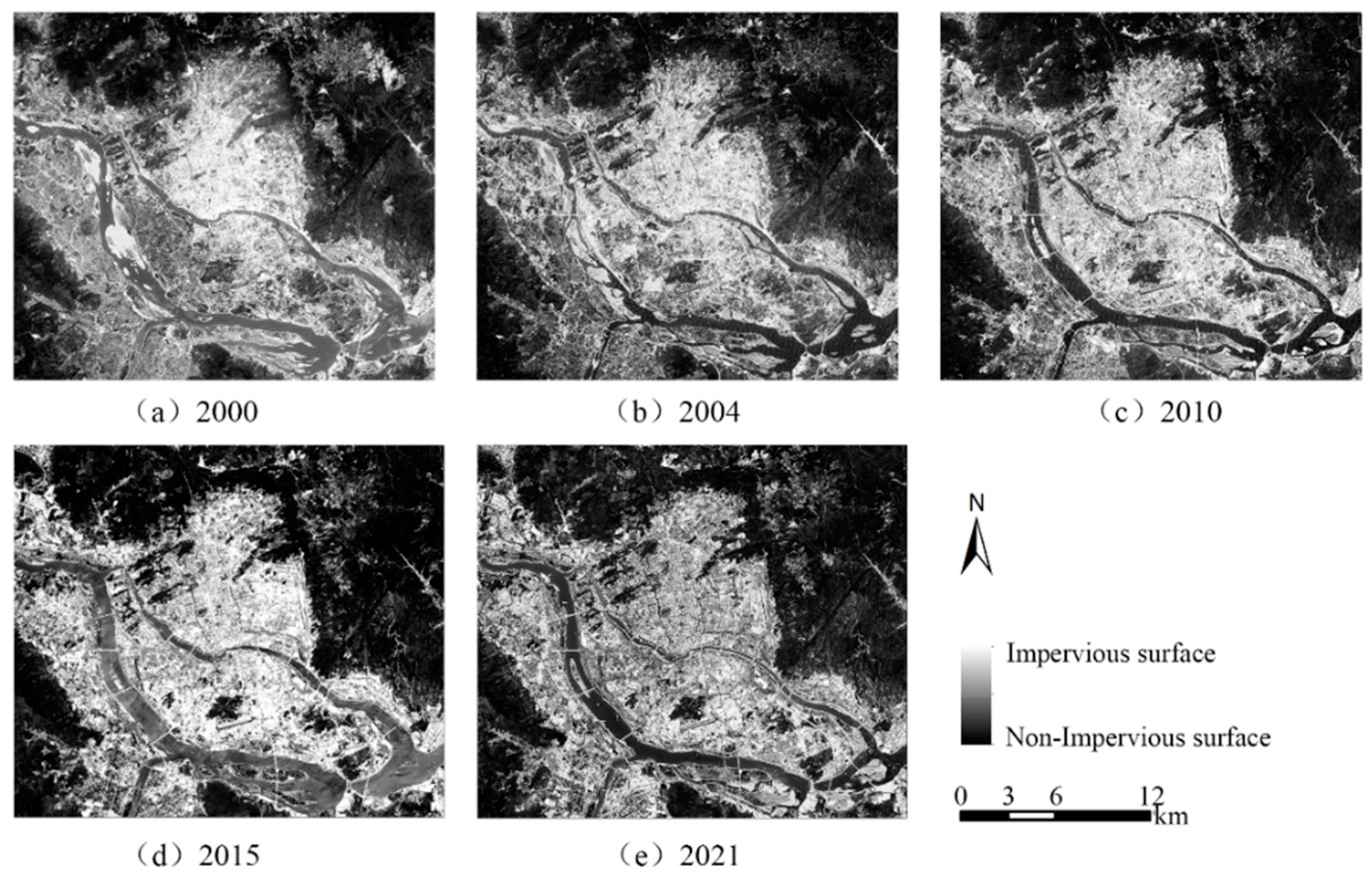


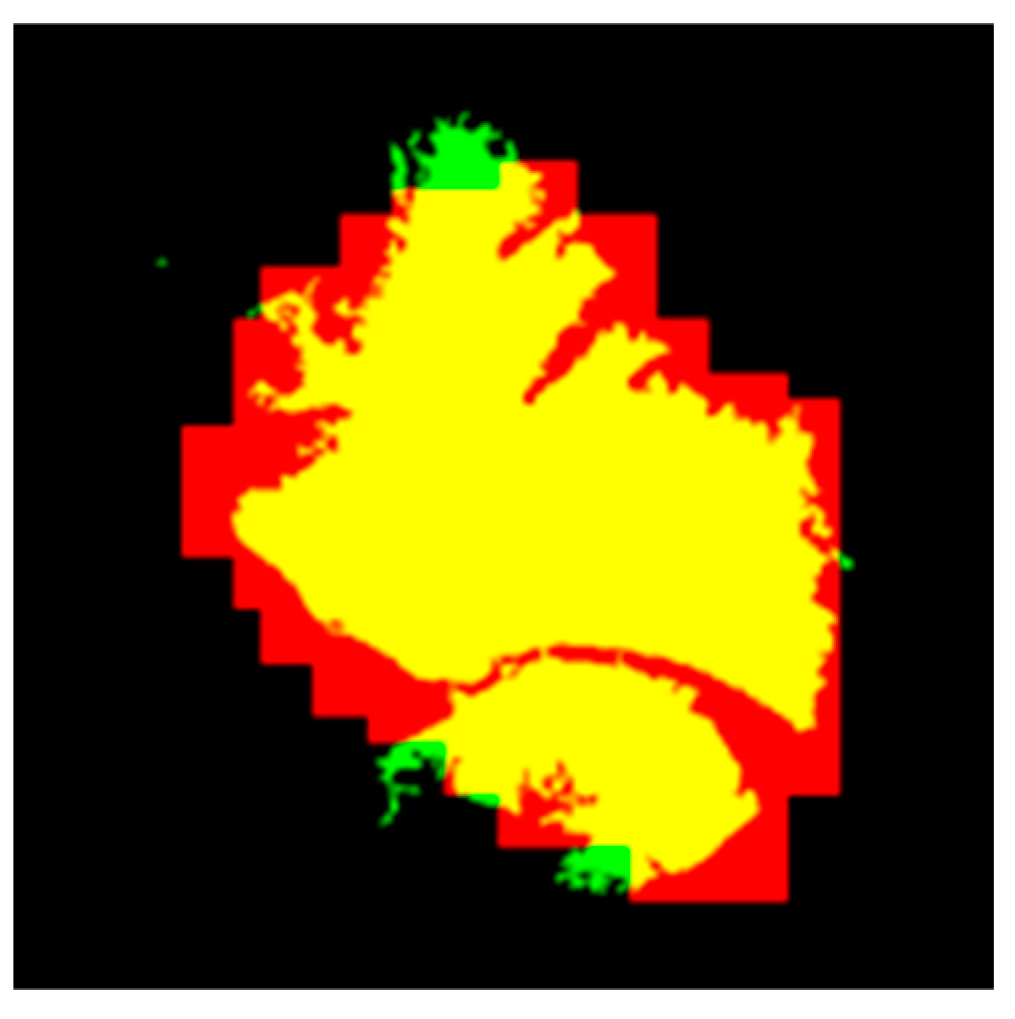
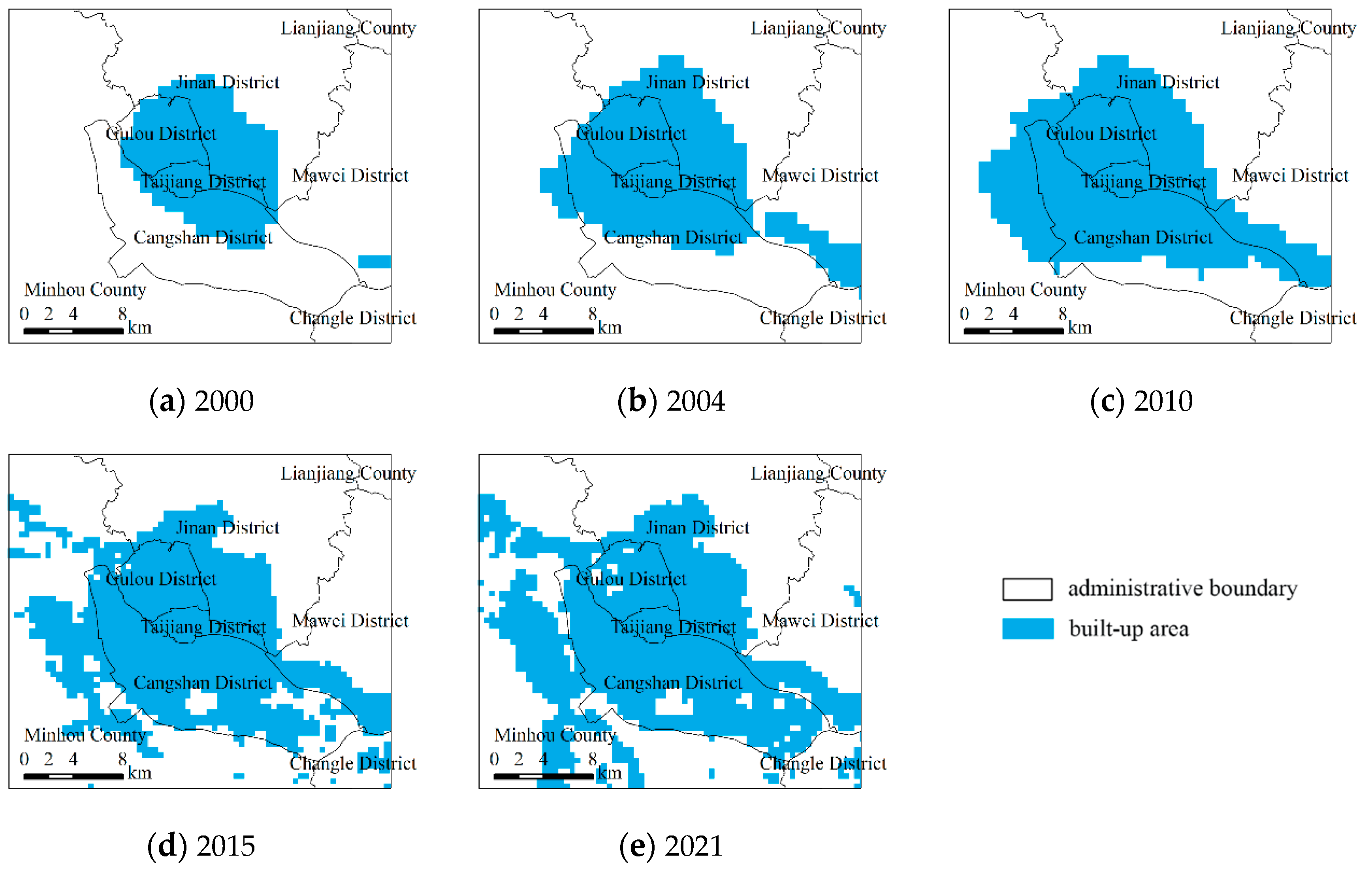
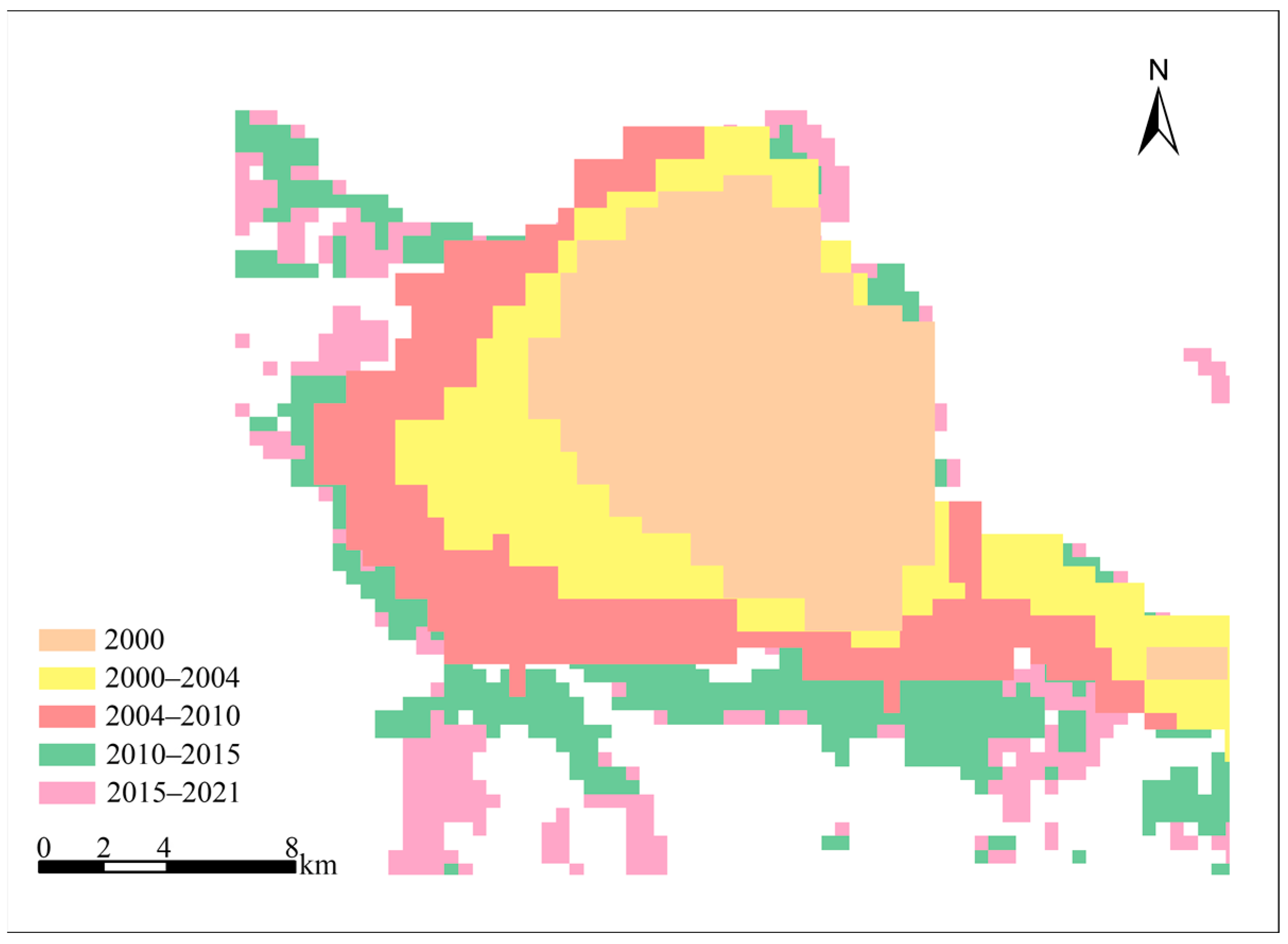


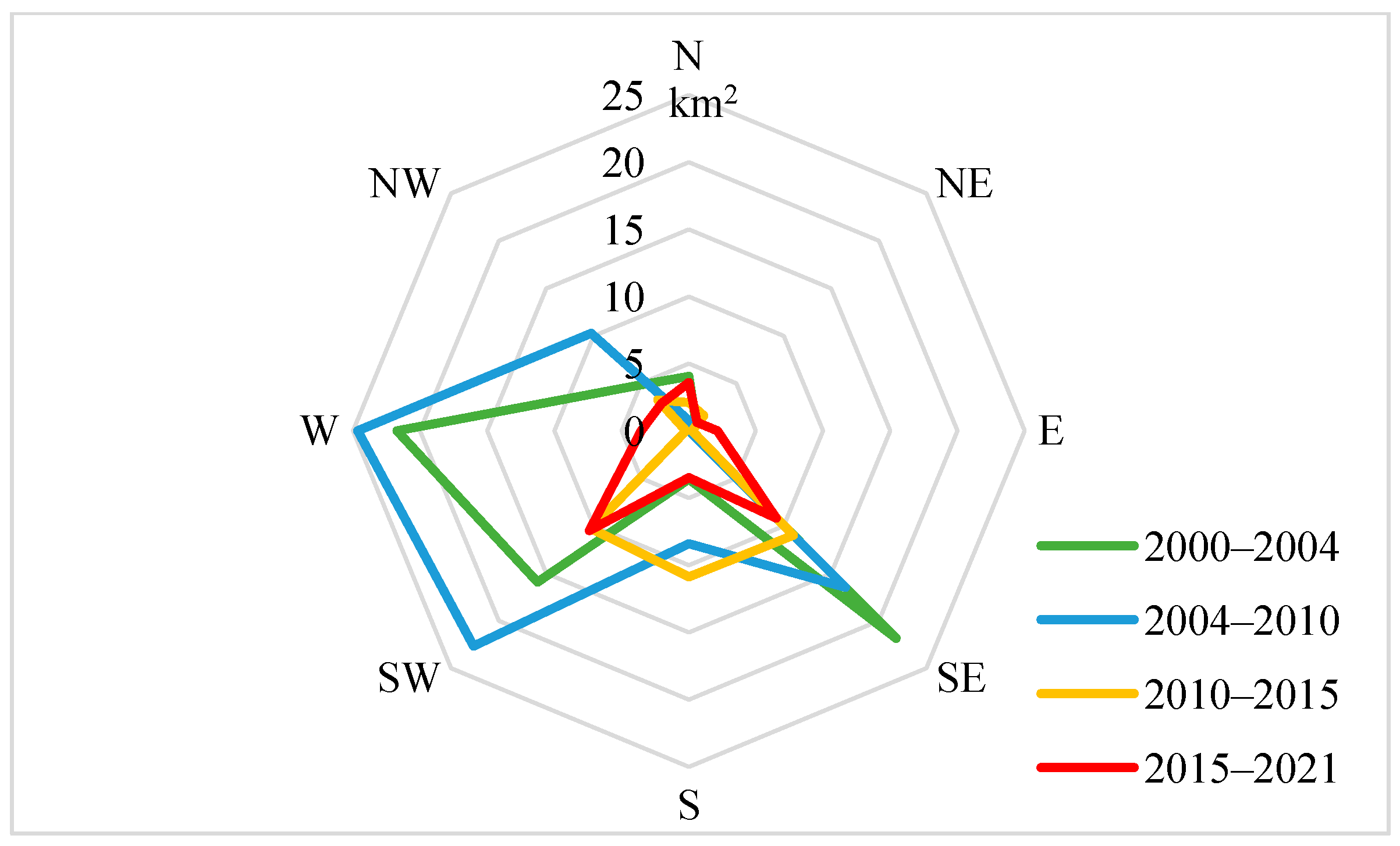

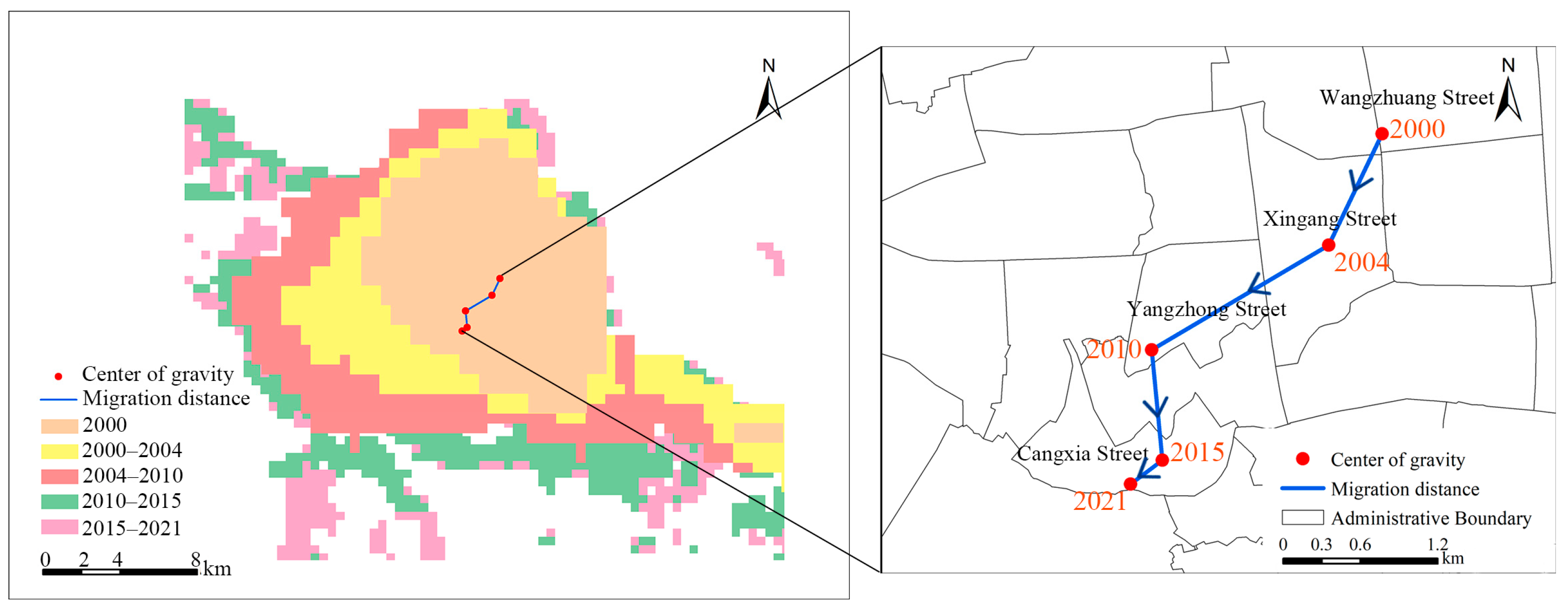


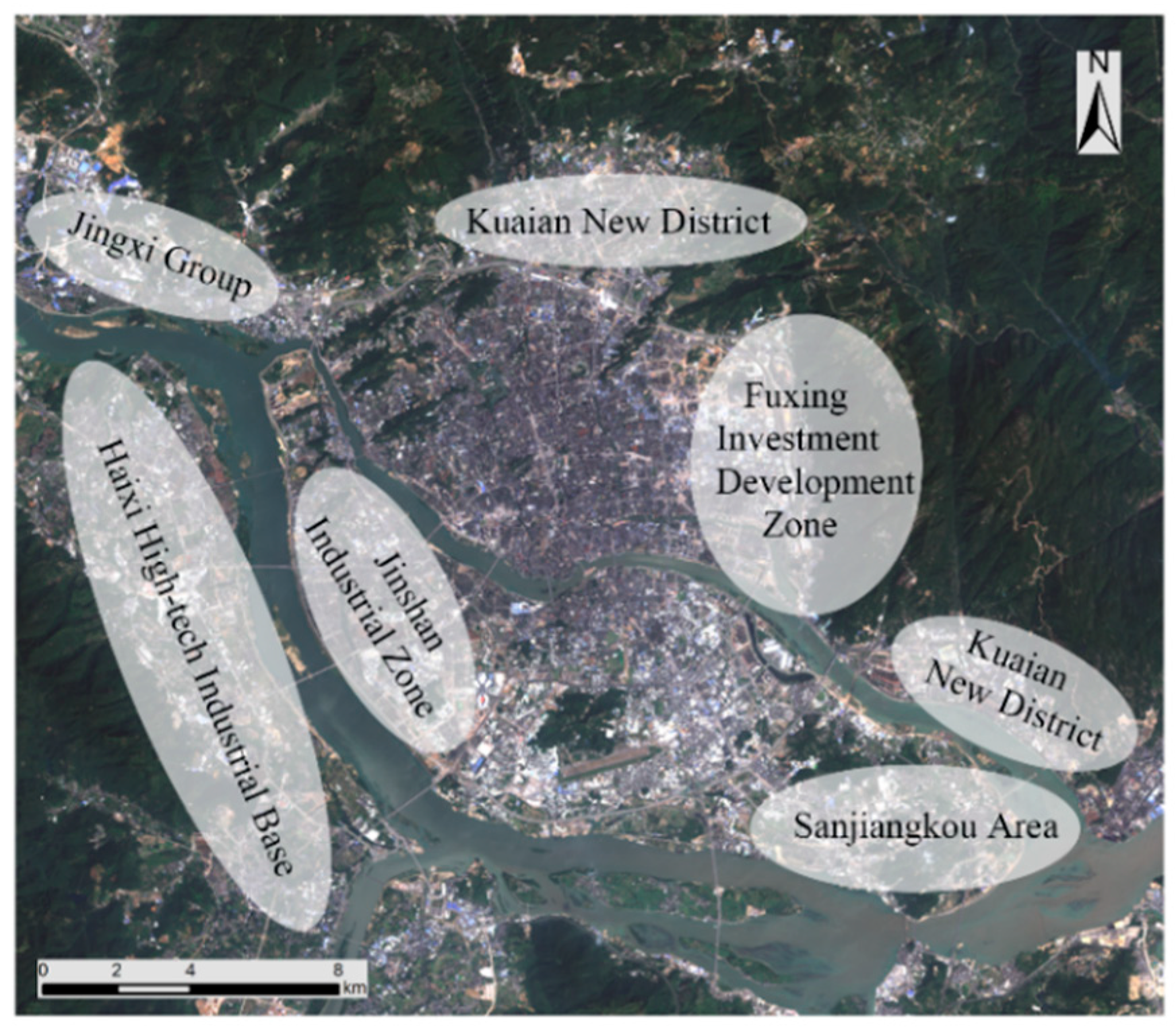
| Satellite | Sensors | Image Date | Spatial Resolution (m) | Radiation Resolution (bit) |
|---|---|---|---|---|
| Landsat7 | ETM+ | 2000-05-04 | 15, 30, 60 | 8 |
| Landsat5 | TM | 2004-10-30 | 30, 120 | 8 |
| Landsat5 | TM | 2010-10-31 | 30, 120 | 8 |
| Landsat8 | OLI | 2015-09-27 | 15, 30, 100 | 16 |
| Landsat8 | OLI | 2021-09-27 | 15, 30, 100 | 16 |
| Satellite | Sensors | Image Date | Sensor Type | Spatial Resolution | Description | Location |
|---|---|---|---|---|---|---|
| DMSP | OLS | 2000 | F15 | 1 km | Annual synthetic data | Global |
| DMSP | OLS | 2004 | F15 | 1 km | Annual synthetic data | Global |
| DMSP | OLS | 2010 | F18 | 1 km | Annual synthetic data | Global |
| NPP | VIIRS | 2015-09 | / | 500 m | Monthly synthetic data | 75N/60E |
| NPP | VIIRS | 2021-09 | / | 500 m | Monthly synthetic data | 75N/60E |
| Sensor | Year | a | b | c | R2 |
|---|---|---|---|---|---|
| F14 | 2000 | 0.0032 | 0.8417 | 1.9365 | 0.8498 |
| F15 | 2000 | 0.0065 | 0.5452 | 3.7070 | 0.8095 |
| F15 | 2004 | −0.0070 | 1.3911 | 1.1871 | 0.9021 |
| F16 | 2004 | −0.0007 | 0.9963 | 1.3730 | 0.8576 |
| F18 | 2010 | 0.0086 | 0.2585 | 3.5162 | 0.8716 |
| Year | Area of Built-Up Area Extracted from Landsat Image (km2) | Area of Built-Up Area Extracted from NTL Data (km2) | Error Value | Error Rate (%) |
|---|---|---|---|---|
| 2000 | 91.3386 | 88.8600 | −2.4786 | −2.79% |
| 2004 | 156.9080 | 154.4535 | −2.4545 | −1.59% |
| 2010 | 211.5900 | 220.0446 | 8.4546 | 3.84% |
| 2015 | 290.5950 | 295.3323 | 4.7373 | 1.60% |
| 2021 | 356.9980 | 358.2729 | 1.2749 | 0.36% |
| Year | X (km) | Y (km) | Offset Distance (km) | Offset Angle (°) |
|---|---|---|---|---|
| 2000 | 731.8726 | 2885.9664 | / | / |
| 2004 | 731.4568 | 2885.1005 | 0.9605 | 115.65 |
| 2010 | 730.0784 | 2884.2852 | 1.6015 | 149.40 |
| 2015 | 730.1620 | 2883.4273 | 0.8621 | 84.43 |
| 2021 | 729.9131 | 2883.2414 | 0.3106 | 143.25 |
| Classification Indicators | Category | 2000 | 2004 | 2010 | 2015 | 2021 | Relevance | Relevance Ranking |
|---|---|---|---|---|---|---|---|---|
| GDP per capita (CNY) | Economic | 1 | 0.9703 | 0.9526 | 0.8776 | 0.6971 | 0.8995 | 1 |
| The proportion of tertiary industry (%) | Economic | 1 | 0.9366 | 0.8929 | 0.8318 | 0.7950 | 0.8913 | 2 |
| Resident population (10 thousand people) | Population | 1 | 0.9350 | 0.8913 | 0.8341 | 0.7918 | 0.8904 | 3 |
| Average wage of employees (CNY) | Economic | 1 | 0.9917 | 0.9257 | 0.8043 | 0.6893 | 0.8822 | 4 |
| The proportion of secondary industry (%) | Economic | 1 | 0.9358 | 0.8855 | 0.8204 | 0.7648 | 0.8813 | 5 |
| GDP (CNY 100 million) | Economic | 1 | 0.9826 | 0.9300 | 0.8030 | 0.5719 | 0.8575 | 6 |
| The proportion of primary industry (%) | Economic | 1 | 0.9106 | 0.8461 | 0.7817 | 0.7354 | 0.8548 | 7 |
| Total retail sales of social consumer goods (CNY 100 million) | Social | 1 | 0.9886 | 0.8315 | 0.6316 | 0.5230 | 0.7949 | 8 |
| Year-end deposit balances of financial institutions (CNY 100 million) | Social | 1 | 0.9444 | 0.7435 | 0.5746 | 0.4346 | 0.7394 | 9 |
| Financial revenue (CNY 100 million) | Social | 1 | 0.9398 | 0.7477 | 0.5310 | 0.4199 | 0.7277 | 10 |
| Financial expenditures (CNY 100 million) | Social | 1 | 0.9962 | 0.7951 | 0.3333 | 0.4271 | 0.7104 | 11 |
| Total social fixed investment (CNY 100 million) | Social | 1 | 0.9660 | 0.5928 | 0.3810 | 0.3671 | 0.6614 | 12 |
Disclaimer/Publisher’s Note: The statements, opinions and data contained in all publications are solely those of the individual author(s) and contributor(s) and not of MDPI and/or the editor(s). MDPI and/or the editor(s) disclaim responsibility for any injury to people or property resulting from any ideas, methods, instructions or products referred to in the content. |
© 2023 by the authors. Licensee MDPI, Basel, Switzerland. This article is an open access article distributed under the terms and conditions of the Creative Commons Attribution (CC BY) license (https://creativecommons.org/licenses/by/4.0/).
Share and Cite
Zhang, F.; Gao, Y. Study on Temporal and Spatial Characteristics of Fuzhou Built-Up Area Based on Remote Sensing Data of Nighttime Light. Sustainability 2023, 15, 2423. https://doi.org/10.3390/su15032423
Zhang F, Gao Y. Study on Temporal and Spatial Characteristics of Fuzhou Built-Up Area Based on Remote Sensing Data of Nighttime Light. Sustainability. 2023; 15(3):2423. https://doi.org/10.3390/su15032423
Chicago/Turabian StyleZhang, Feiyan, and Yonggang Gao. 2023. "Study on Temporal and Spatial Characteristics of Fuzhou Built-Up Area Based on Remote Sensing Data of Nighttime Light" Sustainability 15, no. 3: 2423. https://doi.org/10.3390/su15032423





